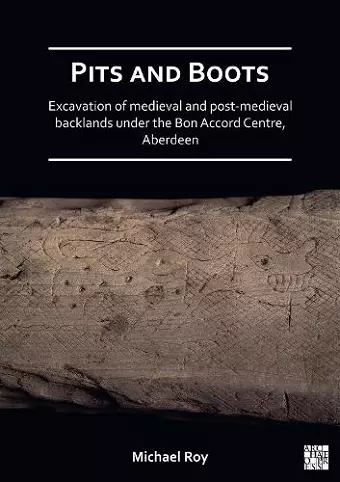Pits and Boots: Excavation of Medieval and Post-medieval Backlands under the Bon Accord Centre, Aberdeen
Format:Paperback
Publisher:Archaeopress
Published:13th May '21
Currently unavailable, and unfortunately no date known when it will be back

Pits and Boots derives from excavations carried out in 2007-8, in advance of an extension to the Bon Accord Centre in Aberdeen, that uncovered the backlands of an area that would have formed part of the industrial quarter of the medieval town. The site is well-dated by dendrochronology, augmented by artefactual evidence, and indicates activity from the late 12th century AD into the early modern period, with a particularly intensive period in the 13th century. Structural evidence consists primarily of the backland boundaries, hearth/ovens, several wood-lined wells and many large pits. It is the contents of these pits and wells which forms the core of this monograph. The waterlogged conditions within the pits and wells has meant that a remarkable assemblage of organic remains including leather, wooden artefacts, textiles, animal pelts, fibres, and cordage has survived. The leather assemblage is the largest ever to be found in Scotland and has revealed a range of activities associated with the use of animal hides, from hide processing to tanning and shoemaking. The wood assemblage is also extensive and includes bowls, platters, coopered vessels and tools. Metalwork, crucibles, clay mould fragments and ceramics all testify to the industrial nature of the area, while the large quantities of animal and fishbone demonstrate that butchery on an industrial scale took place in the area. The excavation charts the changing nature of this once-peripheral area of Aberdeen, from an industrial zone in the medieval period, to horticultural and domestic spaces in post-medieval times, and has thus greatly enhanced our knowledge of Scottish urban development.
‘…the monograph provides a clear, well-researched and well-presented account of excavations undertaken in Aberdeen in 2007–8; it examines medieval backland industry followed by later, more affluent domestic occupants; it explores the burgh’s wider trade connections in Britain and beyond; it synthesises a wealth of remarkable organic material; it discusses extraordinary finds such as a late 12th- or early 13th-century stone-and-wooden composite grinding lathe; and it does all this with good photographs and figures throughout, using clear print on quality paper.’ – Brian Ayers (2022): Medieval Archaeology, 65/2, 2021
ISBN: 9781789694871
Dimensions: 290mm x 205mm x 19mm
Weight: 1300g
368 pages